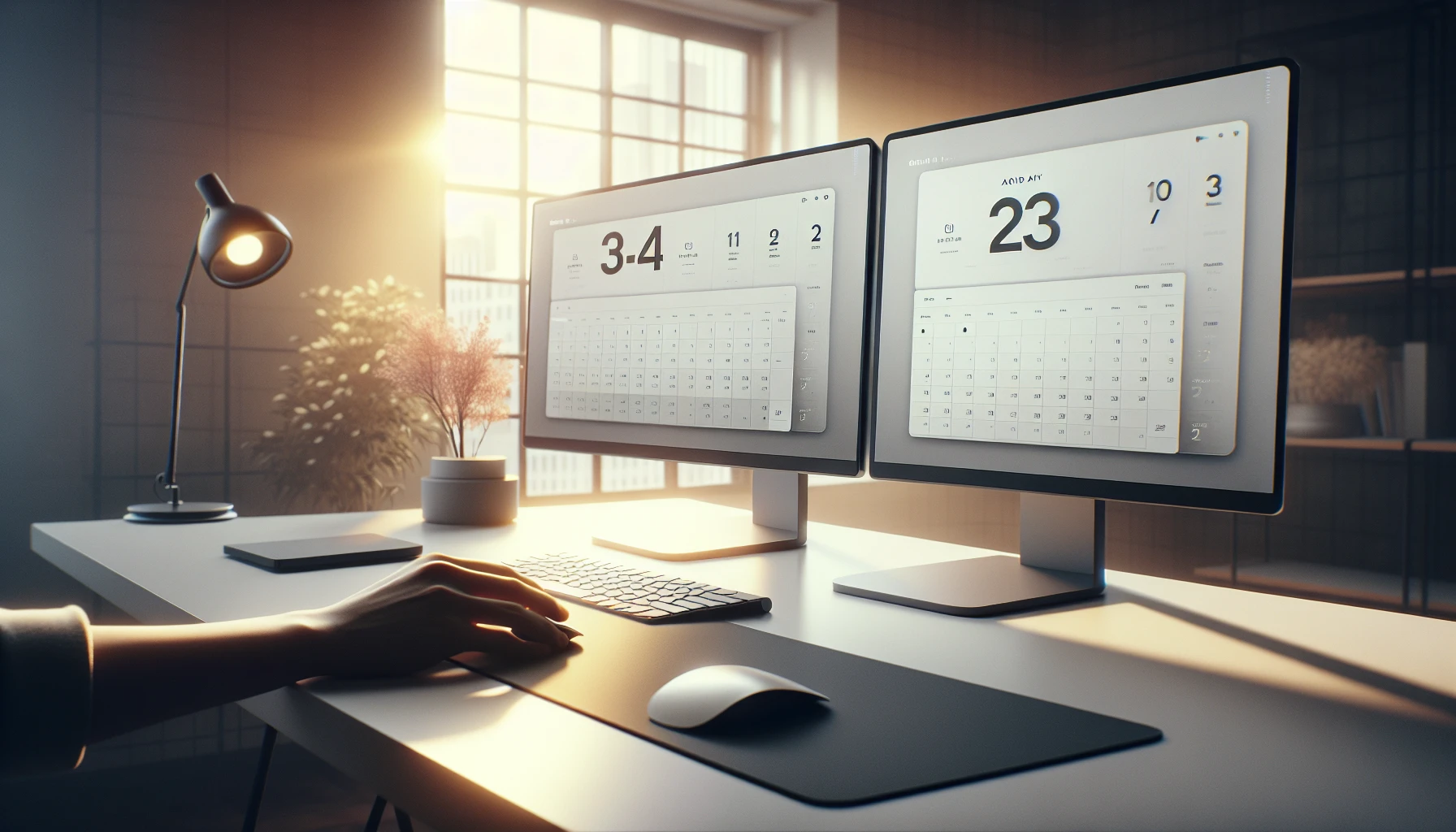· Ricardo Batista · 12 min read
Master Auto Reminder Emails for Efficiency
Learn how auto reminder emails streamline tasks, reduce errors, and enhance productivity. Discover tools and tips for improving your workflow and ensuring timely follow-ups.

Today’s fast-moving existence, remaining structured & productive is crucial for achievement. Automated notification messages are a potent instrument which can simplify your work process & guarantee you don’t overlook any vital task or due date. Through automating this procedure, you can conserve time, diminish manual mistakes, & amplify productivity. Let’s investigate how you can excel at the skill of automated reminder communications to enhance your everyday operations.
Key Takeaways
- Auto reminder emails can significantly improve productivity by streamlining workflow and reducing manual errors.
- Leveraging tools like Meeting Reminders can enhance meeting management by automatically notifying late attendees.
- Customizing notification messages & combining them with email services like Gmail can enhance communication productivity.
- AI and automation tools offer personalized solutions for setting up effective reminders tailored to individual needs.
- Success stories highlight the tangible benefits of using auto reminders in both business and personal settings.
Introduction to Auto Reminder Emails
Definition and Importance
Automated notification messages are mechanized communications transmitted to persons or assemblages to prompt them of imminent happenings, duties, or due dates. These dispatches are activated by predetermined standards or timetables inside an email automation framework. The significance of auto reminder correspondences resides in their capacity to assist with overseeing time & responsibilities more proficiently, guaranteeing that crucial exercises are not disregarded in the scramble of everyday tasks.
Benefits of Automating Email Reminders
Automating email reminders offers several key benefits:
- Saving Time: Automation decreases the requirement for human involvement. After it’s established, the system handles the reminders automatically, freeing up precious time that could be redirected towards more crucial duties.
- Uniformity: Mechanized frameworks guarantee that notifications are dispatched at precisely the opportune moment, each time, keeping up consistency in correspondence.
- Expandability: Regardless if it’s a couple of notifications or a huge number, mechanized frameworks can deal with the size without extra exertion, making it perfect for developing organizations.
- Lowering Mistakes by Humans: Automating the process of sending reminders reduces the likelihood of human mistakes, like forgetting to send a reminder.
- Boosted Involvement: Opportune notifications might escalate participation by retaining activities, gatherings, or happenings at the forefront for attendees.
For those managing frequent meetings, Meeting Reminders can be particularly helpful. This tool integrates with Google Calendar to automatically alert participants who are not attending meetings. It gets rid of the requirement to manually monitor attendance & send reminders, thereby simplifying meeting management.
To find out more about establishing compelling reminders, think about investigating how to make impactful reminder messages in our thorough guide on how to compose reminder emails for gatherings. This source offers practical advice & templates to boost the impact of your communication approach.
Setting Up Auto Reminder Emails with Zapier
Understanding Zapier’s Workflow
Zapier is a platform which links your applications & mechanizes processes, rendering it an excellent tool for establishing auto-reminder messages. It functions by generating “Zaps,” which are automated sequences that connect your apps & carry out repetitive tasks for you. Each Zap is made up of a trigger (the occurrence that initiates the workflow) & one or more actions (the events that transpire automatically). For instance, getting a new event in Google Calendar could trigger an email reminder to be dispatched a day prior to the event.
Step-by-Step Guide to Creating an Email Reminder
To set up an auto reminder email using Zapier, follow these steps:
- Sign Up or Log In: First, create an account on Zapier or log in if you already have one.
- Create a New Zap: Click on “Make a Zap” in your dashboard.
- Set Up the Trigger:
- Choose the app that will trigger the reminder. For instance, select Google Calendar if the reminder is for events.
- Select the specific trigger event, like “New Event”.
- Connect your Google Calendar account and configure the trigger settings.
- Set Up the Action:
- Choose the app where the action will occur, typically an email service like Gmail.
- Select the action event, such as “Send Email”.
- Link your email account & personalize the email layout. Incorporate specifics like receiver email, subject heading, & the content of the notification.
- Test and Activate: Test the Zap to ensure it works as expected. Once confirmed, activate the Zap.
By automating reminders, you not just guarantee timely notifications but additionally decrease the workload on managing manual reminders. For those who handle multiple meetings, incorporating tools like Meeting Reminders can further boost productivity. This service automatically alerts attendees who are tardy to meetings, integrating effortlessly with Google Calendar to keep your schedule running efficiently.
For more insights on improving your email reminders, explore different tactics & templates in our thorough guide on creating effective reminder emails. This resource will assist you in crafting reminders that encourage timely responses & participation.
Using Microsoft Power Automate for Email Reminders
Features and Capabilities
Microsoft Power Automate is a strong tool intended to simplify workflow automation across different apps & services. It allows users to create automated workflows between apps, which could involve sending automated emails based on particular triggers. Main features include a wide variety of pre-built connectors, templates, & the ability to create custom flows. This versatility makes it an excellent option for businesses wanting to automate their reminder systems efficiently.
Creating a Reminder Workflow
Setting up an email reminder workflow in Microsoft Power Automate involves a few detailed steps:
- Access Power Automate: Log in to your Microsoft Power Automate account.
- Make a Fresh Progression: Pick ‘Produce’ from the left-side menu & opt for ‘Automated Cloud Progression’. Give your progression a title and establish the trigger that will commence the email reminder procedure.
- Describe the Trigger: For reminders, you could pick a trigger like a fresh calendar occasion in Outlook or a deadline in Microsoft To Do. Set up the trigger by mentioning the required circumstances.
- Put an Activity: Following the trigger, include an action to dispatch an electronic message. Pick your email program, like Outlook, & utilize the ‘Send an email (V2)’ action.
- Alter Your Message: Complete the specifics of the communication, like the receiver, topic, & content. You could customize the message substance utilizing dynamic stuff from your trigger.
- Save and Test: Save your workflow and perform a test to ensure it works as expected.
For those handling various or crucial gatherings, incorporating a specialized instrument like Meeting Reminders can additionally improve the efficacy of your communication approach. This apparatus mechanically notifies latecomers, effortlessly integrating with your current calendar apps to guarantee smooth & efficient meeting administration.
To find out more about establishing successful reminders & boosting workflow automation, you could discover additional insights in our comprehensive guide on how to compose reminder messages for gatherings, which provides practical suggestions & illustrations suited to different professional environments.
Leveraging AI and Automation Tools
AI Tools for Personalized Reminders
Artificial Intelligence (AI) has transformed how we handle reminders by bringing in customization & flexibility. AI tools study user conduct, preferences, & schedules to send reminders at the most suitable times. For example, AI can propose the ideal time to send a reminder based on when someone typically checks their email or calendar. This guarantees higher visibility. and action on the reminders delivered.
Examples of Automation Software
Several automation tools can help streamline the process of setting up and managing reminders:
IFTTT (If This Then That): IFTTT permits individuals to make applets which link various apps & devices. As an illustration, you could configure an applet to transmit a reminder email whenever a calendar occasion is nearing. Go to IFTTT’s website to investigate different applets or craft your own.
Boomerang for Gmail: This utility permits individuals to arrange messages to get dispatched at subsequent periods with inherent suggestion capabilities. It’s particularly valuable for follow-up prompts. Discover more about Boomerang & its highlights on their official website.
Gathering Alerts: Particularly made for get-together supervision, Gathering Alerts mechanically informs latecomers who are behind schedule to gatherings. This instrument incorporates with Google Calendar & works effortlessly behind the scenes, guaranteeing that every participant is on schedule without requiring manual follow-ups.
For those seeking to boost their reminder methods furthermore, combining these instruments can massively enhance productivity & efficacy. Whether it’s via AI-powered customization or sturdy automation programs, the aim is to guarantee crucial duties & gatherings are consistently emphasized.
To discover additional info regarding establishing successful alerts & streamlining workflow automation, you could find supplementary insights in our comprehensive guide on generating productive reminder messages, which provides practical suggestions & illustrations adapted to diverse professional environments.
Integrating Auto Reminders with Email Platforms
Using Gmail for Automated Reminders
Gmail provides built-in capabilities & third-party integrations that make establishing automated reminders simple. People can utilize Google Calendar together with Gmail to dispatch reminder emails for forthcoming happenings or due dates. Here’s the way to set it up:
- Create an Event in Google Calendar: Log into your Google account, go to Google Calendar, and create a new event.
- Put Email Alerts: In the happening making window, click on ‘Add notification’ & select ‘Email’ from the choices. Set the time for the reminder, like 30 minutes prior to the event.
- Preserve & Verify: Keep the happening. An automatic email notification will get dispatched to your Gmail at the predetermined period prior to the occasion.
This integration ensures you do not miss important tasks and appointments, enhancing productivity and time management.
Setting Up Reminders in Other Email Services
For users of other email platforms like Outlook or Yahoo, establishing reminders frequently necessitates comparable procedures or the utilization of supplementary instruments:
- Outlook: Use the calendar feature to create events and set email reminders directly within the event options.
- Yahoo & Others: Though certain services might not possess direct reminder capabilities, third-party applications like Boomerang could be incorporated to accomplish comparable outcomes.
For those handling various gatherings & requiring trustworthy reminder capabilities, Meeting Reminders provides a sturdy answer. This utility merges directly with Google Calendar & automatically dispatches alerts to meeting participants who are tardy, guaranteeing proficient time administration without the necessity for manual interference.
To find out more about combining reminder systems with various email platforms, check out our in-depth guide on setting up email reminders, which offers additional info and step-by-step directions tailored to different email services!
Case Studies and Success Stories
Businesses Benefiting from Auto Reminders
Lots of companies have enhanced their operational capability by incorporating auto notification systems. For example, a dentist’s office significantly cut down on no-show rates by putting into practice automated appointment reminders. Patients get timely alerts through email, decreasing forgotten appointments & optimizing the clinic’s timetable. Likewise, a tech firm streamlined its project administration by establishing automated reminders for due dates, guaranteeing tasks are finished on time & projects remain on course.
Personal Productivity Improvements
Youngsters likewise encounter huge advantages from utilizing auto suggestions. A self-employed person visual fashioner figured out how to further develop project conveyance times by setting up updates for every period of their undertakings. This aided them with monitoring cutoff times as well as imparted progress to clients naturally, upgrading client fulfillment! Another model is an understudy who utilized auto updates to oversee study plans and task cutoff times, which essentially worked on their scholarly execution.
These achievement tales emphasize the versatility & usefulness of automatic notifications in diverse circumstances. For individuals seeking to boost gathering productivity, Meeting Reminders provides a specialized remedy by mechanically informing tardy participants, thereby conserving time & enhancing meeting efficiency.
For more in-depth illustrations & additional study on how automated notifications can aid both enterprises & individual efficiency, investigate our thorough manual on how to compose reminder messages for gatherings, which offers knowledge into creating impactful reminder communications.
Conclusion
In summary, automatic notification messages are influential instruments which could transform how we handle responsibilities, meetings, & undertakings. Utilizing mechanization & AI-powered answers, people and companies can boost their output, diminish manual mistakes, and guarantee opportune follow-ups. Consolidating auto reminder frameworks with email stages like Gmail & utilizing particular apparatuses like Meeting Reminders can streamline correspondence & further develop proficiency in different situations.
The achievement tales of companies & people gaining from automated notifications highlight the substantial effect these instruments can possess on everyday activities & individual productivity. Whether it’s decreasing no-show rates in medical facilities, optimizing project management procedures, or enhancing academic performance through improved time management, auto reminders play a vital function in boosting workflow efficacy.
Accepting the abilities of automation & AI technologies, people can open a fresh degree of organization & efficiency in their everyday schedules, eventually resulting in improved time management & enhanced results in both professional & personal efforts.
Frequently Asked Questions (FAQs)
How can auto reminder emails improve productivity in business settings?
Auto reminder emails can boost productivity in business settings by making sure timely communication happens, decreasing missed deadlines, & automating repetitive tasks. By setting up automated reminders for meetings, appointments, & deadlines, businesses can streamline their workflow & improve overall efficiency.
What are the benefits of using Meeting Reminders for managing meeting attendance?
Meeting Reminders provide a handy way for handling meeting participation by automatically informing attendees who are tardy. This tool saves time by getting rid of the need for manual follow-ups & ensures that meetings begin on time with all participants there.
Can auto reminder emails be personalized for individual recipients?
Yes, customized auto notification messages could be individualized for separate beneficiaries by utilizing AI instruments & automation programs. Personalized alerts might incorporate particular subtleties custom-made to every beneficiary, expanding commitment. furthermore, further developing the viability of the updates.
How can I integrate auto reminders with my email platform like Gmail?
Blending automatic notifications alongside email services like Gmail is straightforward. Individuals have the ability to leverage functionalities within Gmail or third-party applications to establish automated reminders for occurrences, duties, or scheduled meetings. Through synchronizing their calendar alongside Gmail, users can obtain timely reminder messages directly delivered to their inbox.
Are there templates available for creating effective reminder emails?
Yes, there are pre-made layouts accessible for making compelling nudge messages. Folks can get to pre-designed formats from email marketing tools or tailor their own formats founded on their particular requirements. These layouts can assist in streamlining the procedure of crafting expert & captivating reminder emails.



